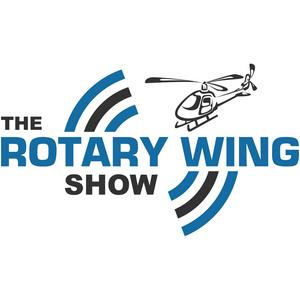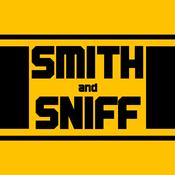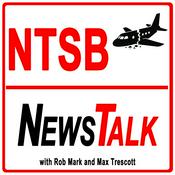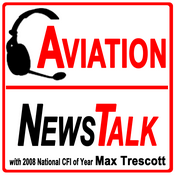Rotary Wing Show – Helicopter News, Safety, Training & Pilot Stories

123 episodes

Mastering Auto-Rotations, Simulated Engine Failures, and Off-Airport Operations + Helicopter News
14/11/2025 | 1h 16 mins.
See Helicopter News headlines and link to listener survey below. In this episode, Max talks with helicopter instructor Jay Bunning to explore the maneuvers that most frequently injure or kill helicopter instructors—auto-rotations, simulated engine failures, and off-airport operations. Based on real accident cases, the newest Airman Certification Standards, and decades of training experience, this episode provides a deep masterclass in keeping both CFIs and students alive during the most unforgiving phases of helicopter training.Max opens by noting that a CFI’s primary goal is always survival—because if the instructor walks away, the student probably will too. Jay agrees wholeheartedly and begins with auto-rotations, which remain the number-one source of training accidents in Robinson helicopters, according to Robinson’s own Safety Notice 38. He breaks auto-rotations into three components: the entry, the glide, and the flare. A poor entry, he notes, is the root cause of many accidents, especially when the student mishandles attitude, misses the nose-drop timing, or chases airspeed and rotor RPM in a cycle of over-correction. Jay emphasizes that the instructor must “ghost” the controls, particularly the throttle, because one wrong twist by a nervous student can result in a 130 percent engine overspeed—and the destruction of the helicopter.In the glide phase, Jay explains how new students tend to over-use the collective, chasing RPM changes that take several seconds to settle. Meanwhile, the cyclic creates nearly instantaneous changes in rotor energy, making it critical for CFIs to stay physically close to the control. He also explains how instructors sense impending RPM changes: first by feel, then by sound, and only finally by looking at the tachometer. With decision gates at 100, 200, or 300 feet depending on school policy, Jay stresses that CFIs must call “continue” or “my controls” loudly and decisively—because these final seconds determine whether the flare will have the energy required to prevent a hard landing.High-density altitude makes the entire maneuver more unforgiving. True airspeed is higher than indicated, meaning the aircraft carries much more energy into the flare than pilots expect. Jay’s school now reduces target indicated airspeed by five knots above 6,000 feet density altitude to prevent overspeeds, and he describes why even small pre-flare collective movements can trigger a “three-second time bomb” of rotor acceleration that ruins the timing of the flare.Next, Max and Jay turn to simulated engine failures, which Jay classifies as an even higher-risk procedure than standard auto-rotation entries. During a simulated power failure, the instructor deliberately decays the rotor RPM by rolling the throttle toward idle while calling “engine failure” repeatedly until either the student reacts or the horn sounds. At that moment, the instructor must instantly lower collective to preserve rotor inertia. Jay recounts an incident where a student failed to react and the instructor nearly could not recover RPM. He explains why CFIs must avoid initiating these maneuvers at high manifold pressures or within the yellow arc—because the high blade pitch makes rotor decay almost instantaneous. He also describes a dramatic real-world example in which an R22’s air filter box fell off during a practice auto-rotation, causing the engine to quit on its own. The DPE successfully restarted the engine in the flare, highlighting how these skills can become lifesaving instantly.The final segment focuses on off-airport operations—pinnacles, ridges, and confined areas—where helicopter pilots frequently encounter wires, unseen obstacles, brownout, or downdrafts. Jay stresses that performance planning must include a realistic margin between hover-out-of-ground-effect capability and actual required power. Many pilots, he notes, assume they can pull the additional 1.5 inches of manifold pressure...

CHP Pilot Jan Sears: Wildfire Rescues in Hurricane-Force Winds
28/10/2025 | 58 mins.
In this episode of the Rotary Wing Show, Max Trescott replays a powerful conversation from Aviation News Talk Episode 37, featuring California Highway Patrol pilot Jan Sears. Jan recounts the dramatic night of October 8, 2017, when he and fellow CHP aircrews helped rescue dozens of people trapped by the Atlas Peak Fire, one of the catastrophic Northern California wildfires that claimed 41 lives and destroyed more than 5,700 structures.Sears, based at Napa County Airport, was on a routine patrol in CHP’s GippsAero GA8 Airvan when he first noticed a strange flicker of light on a hillside north of the airport. Within minutes, that faint glow exploded into a fast-moving inferno. Realizing that winds of 50 to 70 knots were driving the flames toward populated areas, Jan radioed Napa County Fire, providing the exact coordinates using the aircraft’s high-resolution infrared camera.As CHP helicopters H-32 and H-16 joined the scene, crews began an unprecedented series of nighttime rescues. Flying through hurricane-force winds, violent turbulence, and smoke thick enough to make Napa Airport IFR, they pulled roughly 50 people and several pets from danger. Jan remained high above in fixed-wing orbit, relaying coordinates, road conditions, and fire boundaries while watching the chaos unfold below. At times, his own aircraft endured near-severe turbulence as he tried to refuel and return to the area.After landing, Jan and his partner spent hours on the ground knocking on doors, evacuating families, and even extinguishing small fires by hand. He describes the scene as one of the worst conditions he has ever flown in — comparable only to his previous deployment to Hurricane Katrina.In the days that followed, CHP Air Operations continued aerial patrols and damage assessments, flew Cal Fire behaviorists and government officials over burn zones, and monitored for flare-ups. The experience deepened Jan’s appreciation for the teamwork among law enforcement, firefighters, and rescue pilots, all operating beyond normal limits to protect lives.Jan also shares insight into his path to aviation — from paramedic to CHP officer to fixed-wing pilot — and explains what it takes to join CHP’s aviation unit. Applicants must complete the full CHP Academy and law-enforcement service before qualifying for flight training, blending police work with advanced aviation operations under Part 91 standards but Part 135-level discipline.Beyond emergency response, CHP aircraft conduct search-and-rescue, suspect tracking, disaster logistics, and donor transport flights statewide. Jan emphasizes the satisfaction of serving California’s citizens from the sky and encourages listeners to support first responders who risk everything in service of others.This gripping episode offers helicopter pilots, public-safety aviators, and general-aviation enthusiasts a rare inside look at what it’s like to fly life-and-death missions in extreme conditions. It’s a story of professionalism, bravery, and teamwork — and a reminder of why pilots like Jan Sears are true heroes of the rotor-wing world.You can find more information about CHP here, and on the CHP Golden Gate Division Air Operations’ Facebook page. It includes a link to this story that ran on the CBS Evening News, about Pepe...

R66 Crash Analysis: Jay Bunning on Low-G Mast Bumping and Turbulence Traps
20/10/2025 | 52 mins.
Max talks with Jay Bunning about the crash of a Robinson R66, VH-KFT, in Australia that claimed the life of its pilot on October 26, 2023. In addition to the final report, ATSB created a video about the crash. The accident offers vital lessons for all pilots flying teetering-rotor systems such as the R22, R44, R66, Bell 206, 505, and others.Mentioned on the ShowPlease take our listener survey to help guide the showHelicopterTrainingVideos.comJay explains that the R66 in this case was nearly new with fewer than 120 hours. The private pilot departed Cessnock Airport for a short VFR flight but diverted east toward the coast to remain clear of clouds at about 1,000 feet. With 25–30-knot southerly winds striking a steep 700-foot headland, the aircraft encountered severe mechanical turbulence. A strong updraft produced a low-G condition—a situation in which the helicopter momentarily loses positive G-force on the rotor system. In that instant, the fuselage and rotor disc move independently, and if the pilot attempts to correct roll with lateral cyclic rather than gentle aft cyclic, mast bumping can occur. Within just 3.4 seconds, the R66 rolled beyond inverted, separated in flight, and crashed into the sea.Thanks to a factory-installed cockpit camera, investigators could analyze the pilot’s exact cyclic movements. The disturbing footage revealed the pilot eating from a bowl with the right hand while the autopilot flew the aircraft. When turbulence hit, the pilot grabbed the cyclic awkwardly with the left hand—unbraced and using the non-dominant arm—while also manipulating a cell phone moments earlier. Jay notes that this combination of distraction, turbulence, and incorrect recovery inputs created a “perfect storm.”The conversation explores the aerodynamics of low-G events, including why teetering systems are vulnerable when unloaded and how horizontal stabilizer design can exacerbate right-roll tendencies. Robinson’s earlier models used an asymmetric stabilizer mounted on the right side of the tail boom, which generated downward lift and contributed to right rolls during low-G conditions. The company has since introduced a symmetrical stabilizer retrofit, now standard on all new helicopters and available at cost to existing owners—a change Jay strongly urges all operators to adopt.Training is another key theme. Jay describes how his flight school safely simulates low-G recognition and recovery without violating limitations, helping pilots build instinctive reactions. “If you feel light in the seat,” he says, “the first response is gentle aft cyclic—never lateral cyclic.” Pilots should also maintain turbulent-air penetration speeds of 60–70 knots instead of cruising at 110 knots, which magnifies control sensitivity and reduces reaction time.Max and Jay broaden the discussion to turbulence awareness and terrain effects. They describe how updrafts form on windward slopes and downdrafts on the lee side, why whitecaps or “cat’s paws” on the water reveal strong surface winds, and how visualizing air like flowing water helps anticipate areas of vertical movement. Both emphasize the importance of scenario-based training—teaching pilots to anticipate risk factors, recognize the first signs of turbulence, and react before a low-G event develops.Human factors were also central to this tragedy. The pilot’s preoccupation with eating and phone...

Helicopter Training Safety: Preventing Student Errors with Jay Bunning – Part 2
03/10/2025 | 1h 4 mins.
Max talks with Jay Bunning, CFI and creator of helicoptertrainingvideos.com, for Part 2 of their series on Helicopter Training Safety: Preventing Student Errors. Following up from Part 1, Jay brings real-world accident examples and practical strategies for instructors to manage common mistakes during training flights.We need your help to improve the show! To do that, we need you to take our Rotary Wing Show Listener Survey. We have a new host and the show may change in some ways, and to guide those changes we need your feedback. So please take a few minutes and fill in the survey now. Also, have you ever have you ever thought that you might like to have Internet service available when you’re flying in either a helicopter or a GA aircraft? To learn everything you need to know about how to set up and use Starlink in a small aircraft listen to episode 400 of the Aviation News Talk podcast. And click here to find the bits and pieces you need to make Starlink work.Quick Stops / Rapid DecelerationsJay begins with rapid deceleration or quick stop maneuvers, which require simultaneous control of cyclic, collective, and pedals. He explains why instructors must guard both pedals closely, since students often apply the wrong pedal or fail to add left pedal when raising collective. Improper collective inputs can also create conditions for vortex ring state (VRS), overspeed, or altitude loss. Jay notes the importance of sequencing training—avoiding quick stops immediately after autorotations to prevent negative transfer, since students sometimes confuse the two and roll off throttle. He also highlights an R44 accident where a CFI invented a non-standard rapid decel procedure that ended in rollover—reinforcing why instructors must stick to manufacturer guidanceVortex Ring State (VRS)The conversation moves to vortex ring state, also known as “settling with power.” Jay explains both the traditional recovery—lowering collective and pushing forward cyclic to gain airspeed—and the Vard (lateral) recovery, which uses collective, left pedal, and right cyclic to slide out of the recirculation. While the Vard technique can recover faster, Jay cautions against prolonged drifting, over-banking, or excessive collective input, which can cause yaw or RPM decay. He stresses training students to recognize the first indications of VRS—unusual vibrations, buffeting, or an increasing descent rate—and recover immediately. Riding a helicopter deep into VRS for demonstration purposes has caused accidents, including the in-flight breakup of an AS350 during training. Both Airbus and Robinson have issued safety advisories warning against prolonged or aggressive inputs during VRS demonstrationsHover AutosFinally, Jay addresses hover autorotations, calling them the most complex maneuver for instructors to teach. The challenge lies in managing throttle, pedals, cyclic, and collective inputs—all in under two seconds, especially in the R22. Instructors must guard against incorrect pedal use, premature collective pulls that balloon the aircraft, or students rolling throttle the wrong way. Jay explains how training should progress gradually, starting with throttle roll-offs on the ground, then introducing forward taxi hover autos before moving to stationary hovers. He also cites an R22 dynamic rollover accident caused by gusty winds and improper cyclic control, reinforcing the...

Helicopter Training Safety: Preventing Student Errors with Jay Bunning – Part 1
09/9/2025 | 1h 6 mins.
Max welcomes Jay Bunning, flight instructor, FAA Safety Team representative, and founder of HelicopterTrainingVideos.com, for Part 1 of a two-part discussion on helicopter training safety and preventing dangerous student errors.Mentioned on the ShowPlease Take our Listener Survey to help guide the future of the showEnter a giveaway to win a copy of Keep Your RPM in the GreenBuilding a Safer Training ProgramJay describes how accident reports, maintenance events, and safety management systems (SMS) have shaped the “Dangerous Student Errors” training program at his flight school. By cataloging and simulating common hazards, new instructors can practice recognizing and intervening before student mistakes lead to costly accidents.Guarding the ControlsA central theme is how CFIs should properly “guard” helicopter controls:Pedals: using a right-leg brace to block incorrect yaw inputs.Collective: keeping a loose monitoring hand to sense movement.Throttle: using different grip levels, from light monitoring to strong “death grip,” depending on the maneuver.Cyclic: applying a color-coded green, yellow, and red system for levels of guarding.Jay explains that instructors must strike a balance—being ready to intervene instantly, but still allowing students to feel and learn from the aircraft.Ghosting Maneuvers & Freezing on ControlsJay introduces ghosting maneuvers, a technique where instructors mentally fly the maneuver simultaneously so they can immediately recognize deviations. He also discusses how to handle students who freeze on the controls, including using leverage, physical prompts, and clear communication.Common Errors in TrainingThe discussion covers some of the riskiest points in instruction:Overspeeds during liftoff caused by tight throttle grips.Pedal mis-inputs during pickups and set-downs, especially on grass.Student frustration and fatigue during hover training.The importance of pre-briefing slope operations and approaches.Jay emphasizes that mistakes are part of learning, but instructors must ensure they stay safe mistakes—not accidents.Resources for Students & CFIsFinally, Jay introduces HelicopterTrainingVideos.com, a free resource with videos, articles, quizzes, and a podcast for helicopter students and instructors. His mission is to make helicopter training safer and more efficient worldwide.This first part of the conversation lays the groundwork for understanding student error patterns and developing CFI techniques to manage them. Part 2 will continue with advanced maneuvers and safety scenarios.
More Leisure podcasts
Trending Leisure podcasts
About Rotary Wing Show – Helicopter News, Safety, Training & Pilot Stories
Listen to Rotary Wing Show – Helicopter News, Safety, Training & Pilot Stories, The Car Podcast with Chris Harris & Friends and many other podcasts from around the world with the radio.net app

Get the free radio.net app
- Stations and podcasts to bookmark
- Stream via Wi-Fi or Bluetooth
- Supports Carplay & Android Auto
- Many other app features
Get the free radio.net app
- Stations and podcasts to bookmark
- Stream via Wi-Fi or Bluetooth
- Supports Carplay & Android Auto
- Many other app features


Rotary Wing Show – Helicopter News, Safety, Training & Pilot Stories
download the app,
start listening.


































